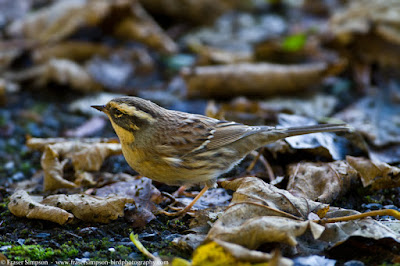We hired a car and arrived at Easington in the early afternoon when the bird had begun to roam more widely than its favoured location of a school yard in suburban gardens adjacent to a gas terminal. While estimates the previous day put the number of birders up to 1400, there were just 50 or so watching now but the bird had flown behind a couple of fences in the gas works and was being rather elusive. Eventually it revealed itself, feeding like a Dunnock, but more furtive in its movement and a lot more colourful! After a couple of hours it returned to the moss-covered tarmac in the garden by which time the light was fading. Here it fed continuously just a few metres in front of us, sometimes in the company of a couple of Dunnocks (Hedge Accentors). In comparison with the common and widespread species, the Siberian stray appeared to be a smaller and neater bird. With a hungry toddler needing fed we headed to our hotel in Aldbrough (nearer locations were booked out) just up the coast, with a stop for fish and chips in Withernsea. We got an idea of just how many migrants were around when a brief look in a couple of trees in a small play park on the promenade here were dripping with Goldcrests, a Yellow-browed Warbler and a couple of Song Thrushes.
Following a great sleep in a four-poster bed and a big Yorkshire breakfast we set off back towards Spurn on the Sunday morning. Problem - it was absolutely chucking it down, and it continued for most of the morning. The forecast was good for the afternoon so in the meantime we birded around Kilnsea and Spurn and as the rain eased, the magic happened. Birds everywhere. In a couple of hours we saw Pallas’s Warbler, Yellow-browed Warbler, Radde’s Warbler and Dusky Warbler. Many other scarcities were being reported and the area was full of common migrants including thrushes, Robins, Goldcrests and Chiffchaffs. By two in the afternoon it was a different day with a big blue sky beckoning us back to the Siberian Accentor for better photographs. We enjoyed a couple of hours watching and photographing it before we had to set of home.
Over the weekend, two further Siberian Accentors arrived in Cleveland and Durham, with a fifth in Northumberland a day later, a sixth on Fair Isle on 20 October. Six records in a week of a bird never seen in Britain before! These were part of unprecedented influx of 103 birds (as of 20.10.16 www.tarsiger.com) across Northern Europe and is generally thought to have been caused by persistent easterly winds produced by a high pressure system over Siberia and Fennoscandia. This is more than three times the number previously ever recorded. Perhaps some other factors were responsible such as misorientation at the point of departure from their breeding grounds. Whatever the cause, a number of other Siberian vagrants including Siberian and White’s Thrush, Pine and Black-faced Bunting, and Easter Crowned Warbler made this one of the most memorable autumns ever. For those of us less fortunate to travel to the extremes of the British Isles, the accentors in north-east England at least gave many another chance. It will be interesting to see what happens in subsequent years. Of course, we may never see another like it in our lifetime. I’ll certainly remember this year for our family trips to see both this and the Siberian Rubythroat. If our young son grows up to become a birder, he’ll only wish he could have remembered!




























































